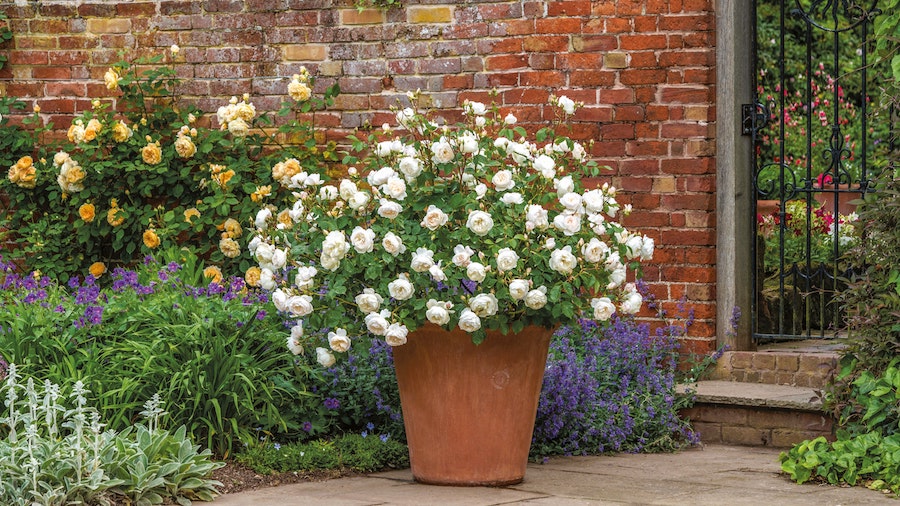Planting up summer pots? Choose 5 plants which just keep on giving
Make your summer pots of colour last all year
Hannah Stephenson chooses 5 permanent plants for containers that will come back year after year.
If you’re short of time but want a riot of colour and some architectural gems on your patio, you may be best off choosing perennials, flowering shrubs and evergreens when you plant up your summer containers.
Planted in the right spot and given the correct care, they can be left in their pots permanently and don’t have to be replanted into a bigger container for years, providing you with plenty of interest long after your neighbours have chucked out their pots of summer bedding and started again.
1. Clematis

Pot-friendly Clematis ‘Giselle’
These are among the most colourful, rewarding climbers which can do well in pots given the right conditions. While some clematis grow to great heights, scaling walls and climbing over fences, there are other smaller and dwarf varieties that are bred with container planting in mind. These include the famous Raymond Evison collection of compact cultivars, including C. ‘Giselle’.

C. ‘Parisienne’
Some compact large-flowered clematis have an extended flowering season and produce more flowers on each stem, flowering from spring and continuing into the summer, including the pale blue ‘Cezanne’ and the deeper blue ‘Parisienne’.
When you’re buying, check the label says the plant is suitable for container planting and its maximum height isn’t going to outgrow the space you have available.

Some clematis grow much taller than others
Ideal for large pots, plant several different varieties to climb up a wigwam or other support and keep their roots shaded, either with other smaller plants or with a mulch of pebbles or other decorative stones.
2. Roses

Rosa ‘Princess Alexandra Of Kent’
While patio roses tend to be unscented and the blooms smaller, there are some compact shrub roses that provide masses of fragrance and huge blooms, like the David Austin English shrub rose ‘Princess Alexandra of Kent’ and its new apricot pink variety ‘Emily Bronte’, which is being launched at this year’s RHS Chelsea Flower Show.
Compact shrub roses need to be planted in large pots, ideally 45cm (18in) across and 60cm (2ft) deep, in a 50:50 mix of John Innes No. 3 and multipurpose compost.
Add some slow release fertiliser to the mix to give it a good start and keep it well watered. You shouldn’t need to repot it for years, just top up the surface with fresh compost every spring.
3. Conifers

The conifer can stay when the pansies are over
There are plenty of dwarf conifers available for pots, most notably the lemon-scented Monterey cypress, which will last for years in a pot.
Using this type of plant to give height in a container also leaves you free to swap smaller more colourful plants as they finish flowering, just digging them out and replacing them with a summer flower, but leaving the conifer in place.
4. Acer

Acer ‘Garnet’ can remain in a pot
For real structural effect, consider planting a dwarf acer (Japanese maple) in a pot. There are many smaller varieties available with an array of leaves ranging from acid yellow to burgundy and everything in-between.
In autumn their colours intensify, providing you with stunning reds, yellows and purples for superb seasonal interest.
5. Succulents

Succulents are drought-tolerant
Succulents including houseleeks (sempervivum) and sedum look terrific in shallower containers, adding interest with their floral structures and foliage colour, which ranges from silver to burgundy.
They are also drought-tolerant, so won’t need as much watering as everything else on a sunny patio, and many will withstand sub-zero temperatures.
The Press Association
Latest posts by The Press Association (see all)
- 6 mind sports to exercise your brain and keep you sharp - December 20, 2024
- Quiz: What classic Christmas food or drink are you? - December 20, 2024
- Leftover turkey and watercress pie - December 20, 2024
- Catherine and William choose family shot for Christmas card photograph - December 19, 2024
- The best books to watch out for in 2025 - December 17, 2024




















